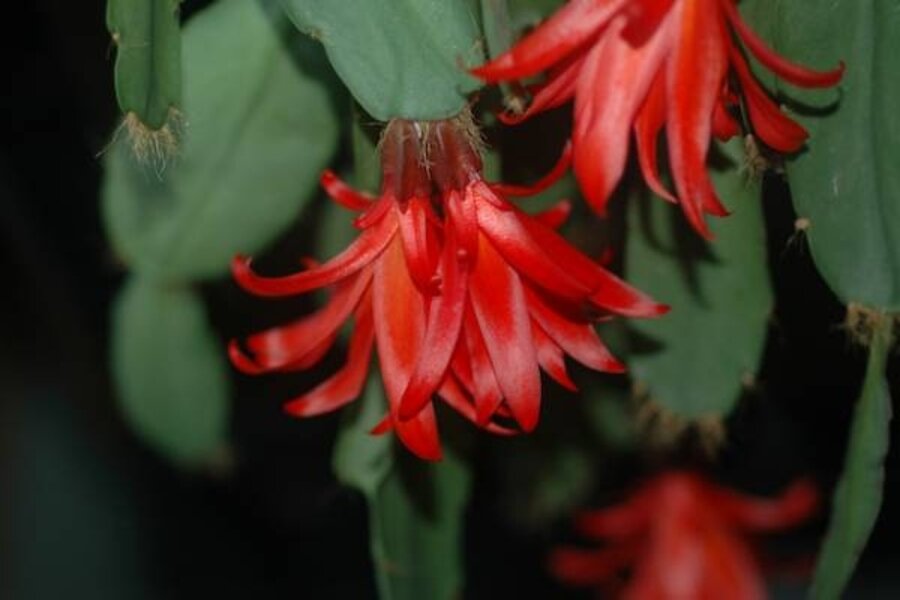Thanksgiving and Christmas cactuses – what you need to know
Loading...
The candy canes and tinsel appeared in my supermarket the day after Halloween, so it’s not shocking that the store also is stocked with Christmas cactuses.
A close inspection reveals not just Christmas but Thanksgiving cactuses. Both members of this seasonal gang are epiphytes, high-elevation jungle species that get most of their nutrients from the air and rain and live in trees like Tarzan. Cactuses yes, desert no.
Thanksgiving and Christmas cactuses, members of the Schlumbergera genus, have glorious backswept petaled flowers that appear between October and February, then again in spring.
They’re easy to grow, pretty much no-kill houseplants that are likely to outlive their cultivators. My neighbors the Laphams are tending a plant that came from his grandmother, and Jody Lapham is older than I am, which is old enough to have grandchildren.
Whether you buy Thanksgiving or Christmas cactus isn’t important, but if you’re a stickler for detail, look closely at the plant’s flattened stems. If it has sharp, hooklike edges, it’s a Thanksgiving cactus; if the edges are rounded, like my neighbor Jody Lapham’s is, it’s a Christmas cactus.
Both flower in May in their native Brazil — flor de maio, or May flower — nowhere near the holidays for which we’ve named them. Funny things, common names.
Epiphytic cactuses want moderate temperatures, soil that drains quickly, occasional doses of diluted fertilizer, filtered light, and water only once the soil is dry to the touch. They also need decent air circulation and like to be slightly pot bound.
Like children, both species benefit from spending the summer outdoors. Bud set depends on temperature and light — the lack of light, actually — so I bring my plants indoors in late fall once the falling mercury and shorter days have produced buds.
From my deck, the pots go to their winter location in the house where they get bright light but not direct sun.
(If your plant doesn't summer outdoors, click here for instructions on getting it to bloom.)
What to avoid indoors? Too much moving around, drafts, and overwatering. All can cause bud or flower drop. And then there are mealybugs. I’ve dabbed with alcohol-dipped cotton swabs and sprayed with insecticidal soap but never was able to eliminate these pests.
My "solution" has been to toss the plant, but I’d be interested in what others have to say.
Schlumbergera breeders have given us bigger flowers in more colors than the usual red — more than 1,000 named cultivars — but red is still handsome, perfect for Christmas. For those who don’t feel traditional, there are white, pink, violet, purple, salmon, tangerine, gold, and bicolored varieties.
If you see a plant that blooms in a color you like — and its owner agrees—snap off a 3- or 4-inch stem segment and set it in a damp peat and sand mixture to root. When roots develop, pot the cutting in an all-purpose potting soil mixed with perlite or bark.
In two years, your plant will have blooms — maybe a week before Thanksgiving or Christmas, maybe weeks after. Merry whatever.
Karan Davis Cutler, a former magazine editor and newspaper columnist, is the author of scores of garden articles and more than a dozen books, including “Burpee - The Complete Flower Gardener” and “Herb Gardening for Dummies.” She now struggles to garden in the unyieldingly dense clay of Addison County, Vt., on the shore of Lake Champlain, where she is working on a book about gardening to attract birds and other wildlife. She will be blogging regularly for Diggin’ It.
Editor’s note: To read more posts by Karan, see our blog archive. The Monitor’s main gardening page offers articles on many gardening topics. See also our RSS feed. You may want to visit Gardening With the Monitor on Flickr. Take part in the discussions and get answers to your gardening questions. If you join the group (it’s free), you can upload your garden photos and enter our next contest.





